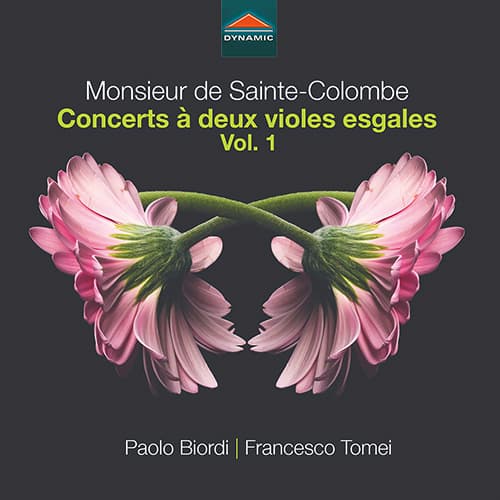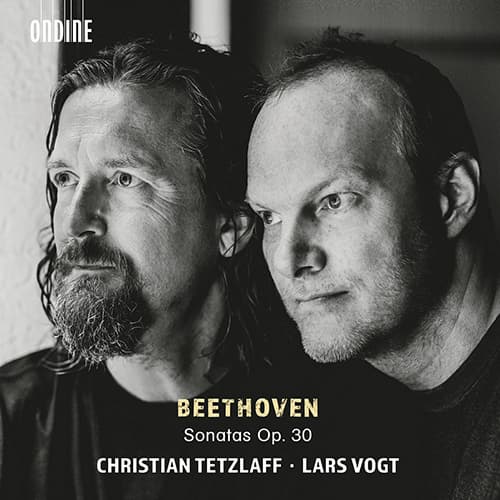It’s the fond memory of many adults raised in America that the Christmas season is the time for Tchaikovsky’s beautiful ballet, The Nutcracker. George Balanchine’s New York production, which had its debut on 2 February 1954, brought E.T.A. Hoffman’s tale of ‘The Nutcracker and the Mouse King’ from 1816 to life. It has been staged in New York and around the world ever since.
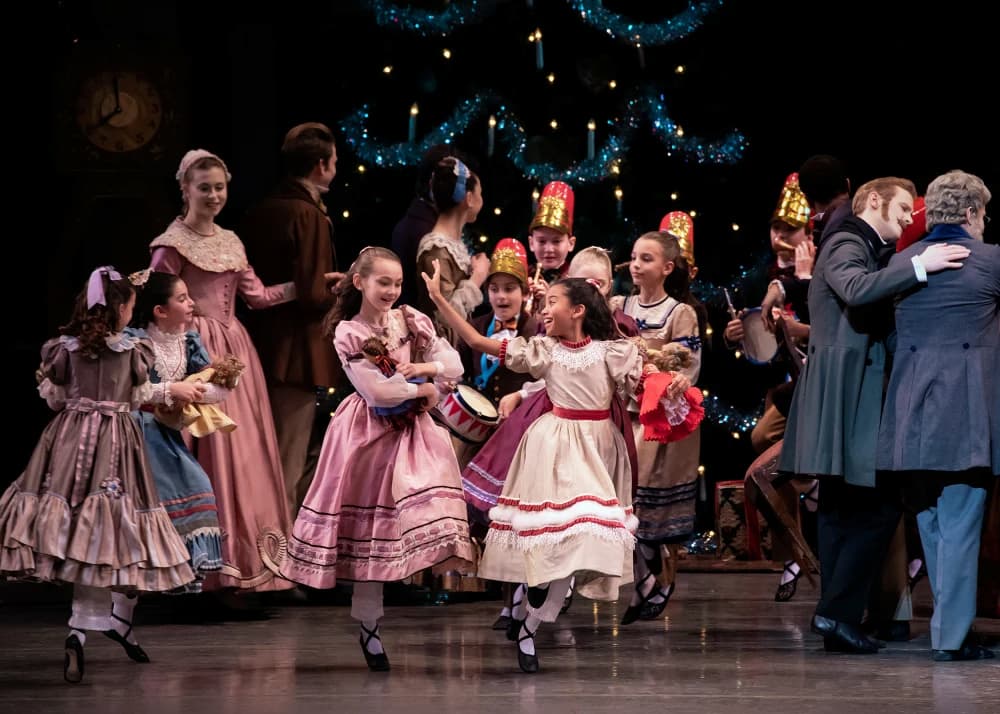
The Nutcracker with Charlotte Nebres as Clara, 2019 (photo by Erin Baiano / New York City Ballet)
Balanchine’s version, albeit in an abridged version, was first televised in 1957 and has appeared on the small screen every year since then. There have been various versions, including 3 different live productions and a film of the full-length ballet (with Macaulay Culkin in a triple role as The Nutcracker, the Prince, and Drosselmeyer’s nephew). It wasn’t until 2011 that the full Balanchine ballet was presented Live from Lincoln Center.
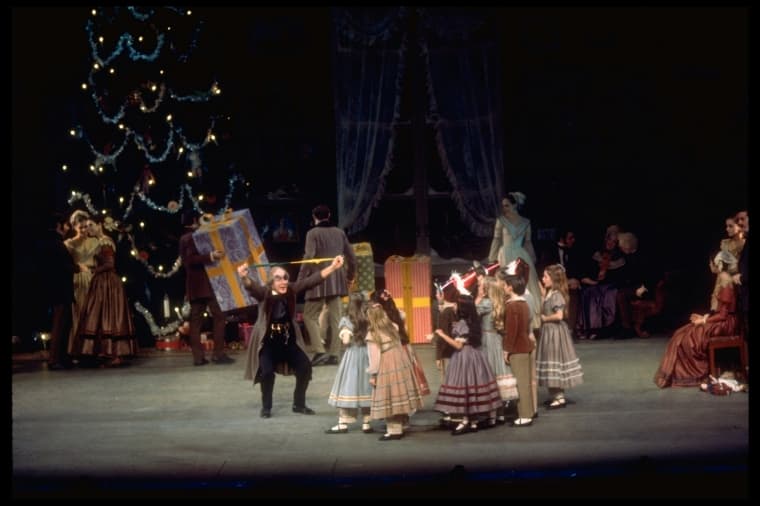
The Nutcracker, with George Balanchine as Drosselmeyer, 1966 (New York City Ballet)
In E.T.A. Hoffmann’s original story, Marie, age 7, and her brother Fritz are celebrating Christmas Eve with their family. Their godfather, Drosselmeyer, a clockmaker and an inventor, brings them a clockwork castle. There is also a nutcracker that Marie is told is for everyone, but she can be his special caretaker. They use him as a nutcracker until Fritz tries him on a nut that is too big and hard, and his jaw breaks. Marie holds him together with a ribbon from her dress. Drosselmeyer promises to repair the nutcracker and takes it away.
After the other children have gone to bed, Marie stays up and, in a dream at midnight, sees the mice, led by the 7-headed Mouse King, emerge from the grandfather clock. The children’s toys come alive, and the nutcracker leads them into battle, wearing Marie’s ribbon as his badge. The dolls are defeated until Marie throws her slipper at the Mouse King, killing him and saving the doll army. In the process, she cuts her arms and faints, only to wake the next morning in bed with her arm bandaged and no one believing her story of the battle that she witnessed.
The story goes into the fantasy from there, with the Mouse Queen seeking revenge, a cursed princess, impossible tasks to be accomplished, and vows to be kept.
Tchaikovsky took over the story in a version created by French author Alexandre Dumas père, who had changed Marie’s name to Clara. His ballet had been commissioned by Ivan Vsevolozhsky, the director of the Imperial Theatres, and he worked with the choreographer Marius Petipa on the storyline. The Hoffmann/Dumas storyline was greatly simplified and an entire section on the Land of the Sweets, not in the original story, was added. Petipa had a definite vision for the ballet and gave detailed instructions to Tchaikovsky, including tempo indications and how long each piece should be. In the middle of the composition, Tchaikovsky broke off work to travel to the US to conduct concerts for the opening of Carnegie Hall.

Konstantin Ivanov: Original sketch for the set of The Nutcracker (1892)
At its opening, the ballet was not a success. Critics hated the children being so prominent and also hated having to wait until late in the second act for the prima ballerina to have her time in the spotlight. The score, on the other hand, was very popular, with critics praising its beautiful music.
As a teaser for the ballet, Tchaikovsky created The Nutcracker Suite, which had its premiere 9 months ahead of the full ballet production. It was instantly popular and consisted of a miniature version of the Overture, six of the characteristic dances (including the Russian, Arabian, and Chinese dances), and closes with the Waltz of the Flowers.
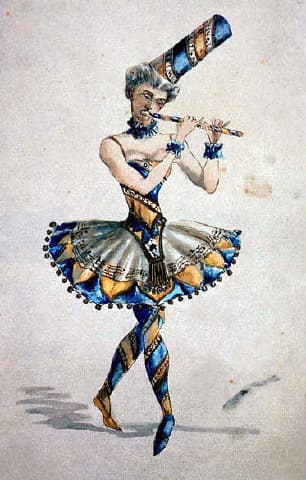
Ivan Vsevolozhsky: Original costume sketch (Dance of the Reed Flutes) for The Nutcracker, 1892
Roger Norrington’s 2007 recording of The Nutcracker Suite brings us the joy of that suite. Tchaikovsky’s selection progresses through the storyline, with the March of the little children starting us into the story line, the Dance of the Sugar-plum Fairy comes next (moved from its position at the end of the ballet) as a transition to the Land of Sweets. Then follows the Russian Dance (a lively Trepak), a sultry Arabian dance for coffee, a Chinese dance for tea, and then the Dance of the Reed Flutes. He closes the Suite with the Waltz of the Flowers. The Suite is all joy.
Pyotr Ilyich Tchaikovsky: The Nutcracker Suite, Op. 71a – I. Miniature Overture: Allegro giusto (South West German Radio Symphony Orchestra; Roger Norrington, cond.)
One critic noted that the Suite removes all the fears and frights that are part of the ballet as a whole: nocturnal battles between mice and dolls, death of the Mouse King, and, on a larger scale, the line that Clara dances between childhood and maidenhood. Nevertheless, it is in the Suite that Tchaikovsky’s music brings happiness to the holiday season.
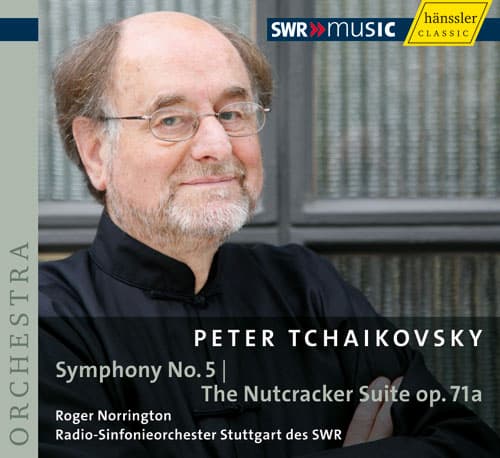
Pyotr Ilyich Tchaikovsky: The Nutcracker Suite, Op. 71a
Performed by
South West German Radio Symphony Orchestra
Roger Norrington
Official Website
For more of the best in classical music, sign up for our E-Newsletter

